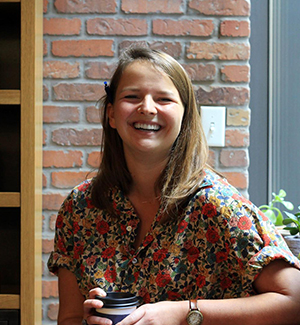Rachael Cusick, an associate producer at Radiolab, spent a year searching for genius. The result is RadioLab Presents: G, a documentary series on the concept of intelligence.

Heather Thorstensen: What was your favorite part about working on RadioLab Presents: G?
Rachael Cusick: There were so many things I loved about working on G – going to the New York Public Library to see original IQ tests, looking for stories that were distinct yet spoke to each other, seeing the beautiful illustrations our talented illustrator created for each episode. But if I had to pick just one, I’d say my favorite part of working on this series for Radiolab was the ability to spend an entire year doing a deep dive on a single topic I knew very little about. As a radio producer, it’s a gift to be able to immerse yourself in a single topic like that. And to be able to do it with the world’s best team captain and radio wiz, Pat Walters? Even better!
HT: What have been the major takeaways for listeners?
RC: The biggest insight I walked away from G with, and something I believe really stuck with our listeners as well, is just how embedded the idea of "intelligence" is in our world. When Pat and I started this series, I really believed the old-school notion of what it means to be "intelligent" was fading into the background. But it wasn’t! The more we worked on the series, the more I saw it in my daily life. Loved ones, coworkers, and television shows—both old and new—lobbed the word “genius” around like a ping pong ball. I attended lectures and parties where “intelligent” was an attribute to be used in introducing someone right after her name and profession. Schools still rely on it as a goal post and a way of monitoring students. And many of us strive, either boldly or quietly, to constantly achieve it for ourselves.
“Intelligence” is steeped in so many parts of our lives. Yet none of us could agree what it meant. The more we began to pick it apart, the squishier it felt to us. And I think that was a major takeaway for our listeners as well.
HT: What types of art and science collaborations did you explore for the series?
RC: The idea of intelligence, understandably so, does not immediately make neon-colored, wacky light bulbs go off in the creative corners of my brain. It sounds stiff and rigid and intimidating. And it is those things. But it’s also complex and powerful and visceral. Our team wanted to find the shared space between those words. And art is a great way to do that. We began episodes with Einstein and ended them with discussions of science fiction. We used original music and actors to make stuffy old IQ tests come alive so it felt like listeners were experiencing the test themselves. We worked with a great illustrator, Deborah Lee, who synthesized the complexities of each episode into artwork that welcomed listeners into each episode. We hosted a live show with science writers and comedians to stare at intelligence from different perspectives. And because of all these art and science collaborations, we were able to explore a deeply scientific idea in vivid, emotionally resonant, and artistic ways.
Hear more about Radiolab Presents: G from Cusick during her keynote address at the virtual Sigma Xi Annual Meeting and Student Research Conference, this November. The meeting will explore interdisciplinary research collaborations, particularly those between art and science.
Heather Thorstensen is the manager of communications at Sigma Xi, The Scientific Research Honor Society.
Updated 6/23/20